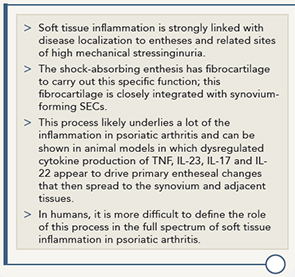
Echoing Dr. Gordon, he also emphasized the need to consider the number of comorbidities often seen in patients with psoriatic arthritis, including obesity, type II diabetes mellitus, hypertension, uveitis, inflammatory bowel disease, anxiety and depression, metabolic syndrome and increased risk of cardiovascular disease. All of these, he said, contribute to increased disability and decreased quality of life and life expectancy.
A better recognition of the many manifestations of psoriatic arthritis can help facilitate an earlier diagnosis and treatment, both of which are often delayed because of the varied presentation of psoriatic arthritis among individuals and the lack of a diagnostic biomarker.
Once diagnosis is made, the challenges of managing psoriatic arthritis arise, said Dr. Ritchlin, because of the dearth of evidence on the efficacy of traditional agents (e.g., methotrexate, azulfidine, cyclosporine, leflunomide), whether traditional agents slow radiographic progression, whether traditional agents are effective for axial disease, dactylitis or enthesopathy, and the multiple comorbidities of many patients.
To help rheumatologists develop a comprehensive and feasible treatment plan, he proposed a treatment strategy guided by clinical features, imaging and biomarkers (see Figure 1). He also emphasized the importance of addressing comorbidities and collaborating with other medical specialists and primary care physicians to manage these conditions, as well as to recognize that certain agents to treat psoriatic arthritis may be contraindicated in patients with specific comorbidities.
Mary Beth Nierengarten is a freelance medical journalist based in St. Paul, Minn.
Second Chance
If you missed this session, Psoriatic Arthritis: Skin, Entheses and Joints, it’s not too late. Catch it on SessionSelect: http://acr.peachnewmedia.com/store/provider/provider09.php.
Key Evidence-Based Medicine References for Physicians
- Lowes MA, Suárez-Fariñas M, Krueger JG. Immunology of psoriasis. Ann Rev Immuno. 2014;32:227–255.
- Wendling D, Guillot X, Prati C. The IL-23/Th17 pathway in SpA: The Royal Road. Joint Bone Spine. 2014. Sep 19. pii: S1297-319X(14)00195-X. doi: 10.1016/j.jbspin.2014.08.003
- Husted JA, Thavaneswaran A, Chandran V, et al. Cardiovascular and other comorbiditis in patients with psoriatic arthritis: A comparison with patients with psoriasis. Arthritis Care Res (Hoboken). 2011;63(12):1729–1735.
- Haroon M, Winchester R, Giles JT, et al. Certain class I HLA alleles and hapylotypes implicated in susceptibility play a role in determining specific features of psoriatic arthritis phenotype. Ann Rheum Dis. 2014 Sep 26. pii: annrheumdis-2014-205461. doi: 10.1136/annrheumdis-2014-205461.
References
- Revicki D, Chau D, Viswanathan HN, et al. 71st Annual Meeting of the American Academy of Dermatology 2013, abstract P6613.
- Reich K, Langley RG, Papp KA, et al. A 52-week trial comparing briakinumab with methotrexate in patients with psoriasis. N Engl J Med. 2011;365(17):1586–1596.
- Leonardi C, Matheson R, Zachariae C, et al. Anti-interleukin-17 monoclonal antibody ixekizumab in chronic plaque psoriasis. N Engl J Med. 2012;366(13):1190–1199.
- Papp KA, Leonardi C, Menter A, et al. Brodalumab, an anti-interleukin-17-receptor antibody for psoriasis. N Engl J Med. 2012;366(13):1181–1189.
- Langley RG, Elewski BE, Lebwohl M, et al. Secukinumab in plaque psoriasis—Results of two phase 3 trials. N Engl J Med. 2014;371:326–338.



